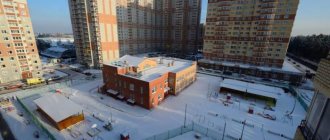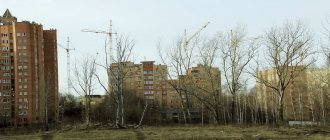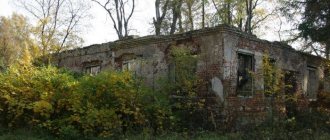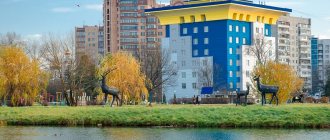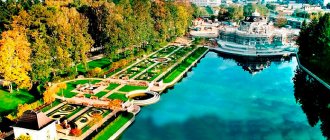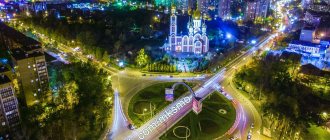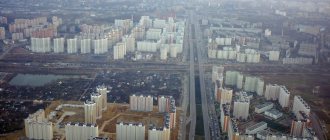Odintsovo district is a unique area of the Moscow region, which includes the ancient Zvenigorod region. Odintsovo district is located in the west of the Moscow region within the boundaries of the forest park belt of Moscow.
The area of the district is 1300 sq. km. The district consists of 28 rural and settlement districts, which number 247 settlements.
The population of the district is 255.5 thousand people, including urban - 171.7 thousand people, rural - 83.8 thousand people.
The administrative center of the district is the city of Odintsovo.
The Moscow-Minsk highway (M1), Mozhaiskoe highway, Rublevo-Uspenskoe highway, and the Belarusian railway pass through the territory of the district. There is an airfield near the city of Kubinka.
Odintsovo district, in socio-economic terms, developed as a territory of recreational importance and providing Moscow with labor.
The basis of the economy of the Odintsovo district is agriculture, medium and small enterprises in the construction complex, enterprises producing consumer goods, a developed system of sanatorium and resort institutions, boarding houses, rest homes, enterprises providing the population with household, utilities, transport and communication services.
Odintsovo joins Moscow. When will this happen and what will it lead to?
Odintsovo is one of the satellites of Moscow, located in the west of Moscow Region. It received city status in 1958 and is currently the administrative center of the city district of the same name.
This settlement is located just 4 km from the Moscow Ring Road, the Mozhaisk Highway passes through it, and the M-1 highway adjoins to the south. The proximity to Moscow is obvious and taking into account the existing trends in development of the near Moscow region (due to the lack of land in the capital) and the gradual rapprochement of territories and merging of infrastructures, the question arises about the likely absorption of Odintsovo by the main metropolis of the country. Next we will consider the issue in detail.
The village of Odintsovo received its name from the boyar family of the same name, which was in the service of Dmitry Donskoy. In the 16th century, the village was located on the route of an important trade road - the Smolensk Tract.
The history of the city’s coat of arms, which includes an image of a Deer, is also interesting: this animal was the companion of the holy martyr Artemon, the patron saint of the father of one of the owners of these lands in the past.
In 1870, the Smolensk-Moscow railway was built, right through the territory of the settlement of Odintsovo, where at that time a working settlement for railway depot workers arose.
During the first half of the twentieth century (we are talking about the Soviet period), the village developed rapidly, new production enterprises arose, the population grew, and the borders expanded.
These factors created all the necessary prerequisites for assigning Odintsovo city status, which happened in 1957. The main part of local products was aimed at providing various types of components and equipment to Moscow enterprises.
The exhibits of the city local history museum, which was opened in 1989, are dedicated to many historical events.
Today the population of Odintsovo is almost 136 thousand people. A significant part of local residents work in the capital - this is facilitated by the proximity of the territory to the Moscow Ring Road.
The city has all the necessary shops, cell phone stores, and representative offices of major banks. There are also several large shopping centers and its own registry office.
The ecological situation can be assessed as favorable: there are quite a lot of ponds, squares and parks. Geographically, the city is divided into 22 microdistricts, most of which have emerged recently, as part of massive residential development.
Directly adjacent to Odintsovo are several completely new Moscow microdistricts and an innovative one.
ODINTSOVO
ODINTSOVO, a city in Russia, in the Moscow region, the center of the Odintsovo urban district. Population 135.5 thousand people. (2019). Located west of Moscow. There are 3 railway stations within the city limits, including Odintsovo. The Mozhaiskoye Highway passes through Odintsovo, along the southern outskirts of the city - the federal highway "Belarus" (Moscow - the border with Belarus).
Story
Photo by D.V. Solovyov Odintsovo. Cathedral of St. George the Victorious. 2004–07.
Photo by D.V. Solovyov Odintsovo. The former office of the brick factory of V. I. Yakunchikova. 1887. Now the Museum of History and Local Lore.
Perhaps, it was first mentioned as the settlement of Odintsovo in the grant of exchange tarkhana and non-conviction letter of the Zvenigorod and Uglich prince Andrei Vasilyevich Bolshoi (Goryaya) to the abbot of the Savvino-Storozhevsky monastery Eusebius dated 19.8.1470. From the end of the 16th century. the village of Odintsovo belonged to the Islenev nobles. It was first mentioned in scribe books in 1627. In 1673–1735 it belonged to the Matveevs. In 1704, A. A. Matveev built a wooden church here in memory of his father in the name of the holy martyr Artemon, Odintsovo received the status of a village. In 1735–60 it belonged to the counts Yaguzhinsky, from 1760 to the counts Efimovsky, from 1800–53 to the counts Zubov, from 1853 to Prince B.V. Meshchersky (from the Meshchersky family). The village suffered during the Patriotic War of 1812; I. Murat’s cavalry corps stopped here at the beginning of September. In 1870, traffic was opened along the Moscow-Smolensk railway line that passed near Odintsovo, a station of the same name was built, around which a station village was formed. In the last third of the 19th century. the picturesque surroundings of Odintsovo turned into a popular holiday destination, the holiday villages of Krasnaya Gorka, Otradnoe and others arose; the village of Odintsovo and station villages became large centers of brick production (by the end of the 19th century, there were 3 factories in each of them, the first was founded in 1875 by P. S. Pavlova; the largest - in 1876, belonged to V. I. Yakunchikov). Soviet power was established in 1918. In 1938, the station village of Odintsovo was transformed into a workers' village. Since 1957, the city has included the villages of Krasnaya Gorka, Verkhnee Otradnoye and Nizhneye Otradnoye, Zheleznodorozhny, as well as the village. Yaskino. It was part of the Kuntsevo (1929–60), Zvenigorod (1960–63) districts of the Moscow region. In 1965, the Odintsovo village included the village of Odintsovo, the villages of Zapadny, the Bakovsky Rubber Products Plant, part of the Bakovka holiday village, and the village of Akishevo. In 1965–2019 the regional center. City of regional subordination (1965–2001, since 2019) of the Moscow region. From 2022 the center of the Odintsovo urban district. In 2022, a new railway line was launched through the city - MCD-1, connecting Odintsovo with the city of Lobnya through the territory of Moscow.
Architecture. Centers of science and culture
The city center is formed around the railway station building (1899–1900, architect L. N. Kekushev). To the northeast of it, a classicist church in honor of the Grebnevskaya Icon of the Mother of God (1797–98; refectory and bell tower - 1896–98, architect S.V. Krygin; next to the chapel 1887) has been preserved with a central rotundal part and adjacent to the rectangular apse 4 -columned portico of the Doric order. Also preserved are: the office of the former brick factory of V. I. Yakunchikova (1887; since 1989 Museum of History and Local Lore), the visiting house of the merchant V. M. Sorokoumov (late 19th century; now a children's music school). In the 1960s–80s. The city center was rebuilt, 8 microdistricts were built with multi-storey residential buildings. Since the beginning of the 2000s. erected: the Church of the Reverend Martyr Elizabeth Feodorovna at the 25th Central Military Clinical Hospital of the Missile Forces, the 5-domed Cathedral of St. George the Victorious (2004–2007), the municipal exhibition center (2002), in the northeast the Kutuzovsky microdistrict (“New Trekhgorka” , 2003–10).
On the northwestern outskirts of Odintsovo and near the city (along the Saminka River) there is one of the largest burial mound complexes in the Moscow region of the 11th–12th centuries, a settlement of the 14th–17th centuries. On the north-eastern outskirts of the city there is the Polet holiday house (the former estate of V. M. Gusev) with the main house in the neoclassical style (1910s). Monuments: V.I. Lenin (1984), G.K. Zhukov (2000, sculptor A.A. Bichukov), memorial “Eternal Flame of Glory” (1975). Humanitarian Institute (2004; building of the same year), branches of universities, including the International Law Institute.
Sport
Women's volleyball club "Zarechye-Odintsovo" (founded in 1987) is one of the strongest in Russia: 2-time champion (2008, 2010) and 6-time winner of the National Cup (1995–2007), winner of the CEV Challenge Cup (2014), finalist of the Champions League (2008) and the CEV Cup (2007). The men's volleyball club "Iskra" (1979) is a multiple winner of the Russian championship, winner of the USSR Cup (1986 and 1987) and Russia (2002), finalist of the Champions League (2004). Both clubs host opponents in the volleyball and sports complex (2006; 3.5 thousand seats). In 2015, the Sports Recreation Park named after. Hero of Russia Larisa Lazutina with a roller ski track.
Farm
The majority of the economically active population is employed at Moscow enterprises. In Odintsovo - the construction and operational department of the Transinzhstroy company, one of the contractors for the construction of the Moscow Metro and other complex engineering facilities, the organization has built numerous industrial and transport infrastructure, social, and cultural facilities. Among the industrial enterprises are the following plants: “Moscow Pump Plant”, paint and varnish “Odilak”, light structures (metal tiles, corrugated sheets), fire-resistant products. Production of cable products (“Elix-Cable”), plastic and aluminum windows, partitions, interior wooden doors, kitchen furniture (“Empire Kitchen”, “Mikevol”), special and uniform clothing (“Magna”, “Odintsovo Garment Factory”) , leather goods (“Podpolye”), cosmetic products (“Red Line”), confectionery (“Odintsovo Confectionery Factory”), frozen vegetables and fruits (“4 Seasons”), baby food (“Babushkino Lukoshko”), etc.
Neighborhood
Near Odintsovo, in the village. Uspenskoe, - Moscow stud farm No. 1 (breeding Oryol and Russian trotting horses, Trakehner breeds, as well as dairy cows of the Ayrshire breed). In the vicinity of the city, many manor ensembles and churches from the 17th–19th centuries have been preserved. To the northwest and north of Odintsovo are: in the village. Headdresses – Spasskaya Church (1694–97) in the Moscow Baroque style; in the village Znamenskoye - Znamenskaya Church (1754–69) in a style transitional from Baroque to Classicism; in the village Uspenskoye - Uspenskoye-Vyazemskoye estate (Assumption Church, 1726–29; house of Prince V.A. Svyatopolk-Chetvertinsky in the early modern style, 1880s; I.I. Levitan worked here in the 1890s); Usovo estate of Grand Duke Sergei Alexandrovich (now the residence of the President of the Russian Federation Novo-Ogaryovo; Church of the Savior Not Made by Hands, 1763–65, extensively rebuilt in 1822–24; cottage house, 1889–92, architect S. K. Rodionov; guardhouses, farm, grotto). In the village Laikovo - baroque 12-sided church in honor of the Kazan Icon of the Mother of God (1762–64, refectory and bell tower - 1903, architect N. N. Blagoveshchensky); in the village Barvikha (on the bank of the Saminka River) - Podushkino estate of N. A. Kazakova (married Baroness Meyendorff; Baroque Church of the Nativity, 1759–60, refectory - 1870; “castle” and outbuilding in the spirit of neo-Gothic and French Renaissance, 1874–85 , architect P. S. Boytsov; is under the jurisdiction of the Administration of the President of the Russian Federation). To the west and southwest of Odintsovo there are preserved: in the village. Yudino – Transfiguration Church of the “octagon on an equal-pointed cross” type (1718–20; courtyard of the Holy Dormition Pyukhtitsa Monastery); in the village Akulovo – 4-pillar Church of the Intercession with 2 bell towers (1807); the Yakovlevs' Perkhushkovo estate (baroque Church of the Intercession, circa 1760, upper tier of the bell tower - 1880, architect I. S. Semenov, paintings 1876; 2-storey house, lower brick floor - 1770s, upper wooden floor - 1822), Osorgino E. L. Shanks (2-story house in the neoclassical style, 1914).
Transport accessibility
The main connection with Moscow is carried out by leaving Odintsovo on the Moscow Ring Road - this option is the most effective due to the proximity of the location.
Communication with the ring road is established through M-1, Krasnogorskoye and Mozhaiskoye highways. Traffic jams are possible, but only during peak hours: the capacity of three major highways at once is quite sufficient.
Alternative option: train from the Otradnoe railway station. The city does not have its own metro. It is ineffective to use the nearest metropolitan platforms in the Solntsevo and Novo-Peredelkino districts, since it is easier to go straight to the Moscow Ring Road in a straight line.
Odintsovo Employment Center
The employment center in Odintsovo effectively interacts with enterprises, organizations, entrepreneurs, and recruitment agencies in finding the necessary vacancies. The Employment Center studies the needs of employers for personnel, conducts retraining and recertification, and organizes advanced training courses for the unemployed population.
The Odintsovo Employment Center offers residents more than 200 vacancies, which can be found on the official website of the Employment Center.
He closely cooperates with the Employment Center on issues of employment and social adaptation, with the Society of Disabled and Persons with Disabilities, and with the social protection of the population of Odintsovo.
The main task of the employment center is to take action to prevent unemployment in Odintsovo and provide social protection for women on maternity leave, as well as the disabled and large families.
Prospects
Odintsovo is a completely self-sufficient, modern settlement with developed infrastructure. The continuation of the trend towards new development, coupled with the city’s close proximity to the Moscow Ring Road, creates the preconditions for complete merging with Moscow in the foreseeable future.
In this case, the locality’s own metro stations may be opened. On the other hand, there are no political or economic reasons for Odintsovo to be absorbed by the capital. These processes do not occur as planned, due to the actual convergence of territories.
Final conclusion
The standard of living of the population of Odintsovo and Moscow today is not much different; all the same benefits of civilization are available in the city, or it is not at all difficult to get to them by personal car/public transport.
Legally, the city is independent, but in fact it is already part of the capital. It is likely that formal unification will occur as part of the next municipal reform, which will mature due to the intensive development of territories in the near Moscow region and the development of their social and transport infrastructures.
Exact information about the annexation of Odintsovo to Moscow is being clarified at the Moscow City Hall. If additional information is received, it will definitely be posted in the article.
Fertility, mortality and natural population growth in Odintsovo
The city's high birth rate has persisted for several years. In 2013, 4,000 newborns were born, in 2014 - 4,800 children, and in 2016, 4,700 children were born.
Due to the high birth rate in the region, the issue of lack of places in kindergartens and overcrowding of classes in secondary schools has become acute. To solve this social problem, funds were allocated for the construction of additional children's educational institutions. Over the past few years, 18 new kindergartens have been opened, and 3 more are planned to open in 2022.
The city's death rate is relatively low. So, in 2012, 700 people died, in 2014 - 800 people.
